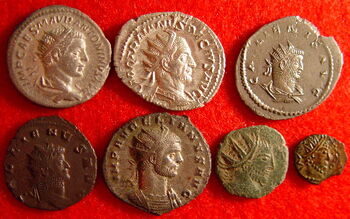
Row 1: Elagabalus (silver 218-222), Trajan Decius (silver 249-251), Gallienus (billon 253-268 Asian mint)
Row 2: Gallienus (copper 253-268), Aurelian (silvered 270-275), barbarous radiate (copper), barbarous radiate (copper)
The Antoninianus was a coin used during the Roman Empire thought to have been valued at 2 denarii. It was initially silver, but was slowly debased to bronze with a minimal silver content. The coin was introduced by Caracalla in early 215, and was a silver coin similar to the denarius except that it was slightly larger and featured the emperor wearing a radiate crown, indicating that it was a double denomination. Antoniniani depicting females (usually the emperor's wife), featured the bust resting upon a crescent moon.
Even at its introduction the silver content was only equal to 1.5 denarii. This helped create inflation: people rapidly hoarded the denarii (see Gresham's law), while both buyers and sellers recognised the new coin had a lower intrinsic value and elevated their prices to compensate. Silver bullion supplies were running short since the Roman Empire was no longer conquering new territory, the Iberian silver mines were exhausted, and a series of soldier emperors and usurpers needed coin to pay their troops and buy their loyalty. Each new issue of the Antoninianus thus had less silver in it than the last, and each contributed to ever-increasing inflation.
In 271 Aurelian increased the average weight of the Antoninianus. This was carried out for a short time. This period was also when the enigmatic 'XXI' was first marked on the reverse of the Antoninianus. The true meaning of this series of numbers is still a topic of debate, but it is thought to represent a 20:1 silver ratio (4.76% silver, which may originally have been 5%, if we allow for silver enrichment on the surface which has been worn away).
By the late 3rd century the coins were almost entirely made of bronze from melted down old issues like the sestertius. Vast quantities were being minted, with a large proportion of the stocks being contemporary forgeries, often with blundered legends and designs. Individual coins were by then practically worthless and were lost or discarded by the millions.

The rapid decline in silver purity of the antoninianus.
Today most of these coins are extremely common finds, with a few more scarce examples (Aemilianus, Marcus Aurelius Marius, Quietus, Regalianus to name a few). The situation was not unlike the hyperinflation of the Weimar Republic in 1920s Germany, when paper money was printed in reckless abundance. The coin ceased to be used by the end of the 3rd century when a series of coinage reforms attempted to arrest the decline by issuing new types.
Modern numismatists use this name for the coin because it is not known what it was called in antiquity. An ancient Roman document called the Historia Augusta (of generally low reliability) refers to silver coins named after an Antoninus on several occasions (several Roman emperors in the late 2nd and early 3rd centuries bore this name, among others). Because Caracalla's silver coin was a new issue, and he had taken Antoninus as part of his imperial name, an association was made with it, and although the association is certainly false, the name has stuck.
